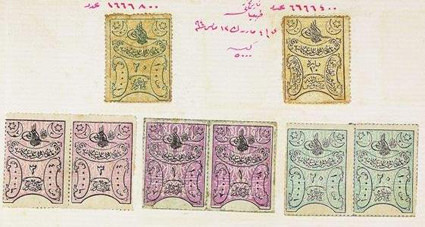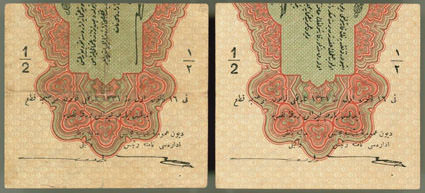
PREV ARTICLE
NEXT ARTICLE
FULL ISSUE
PREV FULL ISSUE
OTTOMAN BANKNOTE EXHIBIT IN ISTANBUL
The Moda Sea Club in Istanbul is currently hosting a comprehensive money exhibition that features Ottoman banknotes dating back to 1840.
-Editor
Mehmet S. Tezçakın, who owns the historic Sultanahmet Köftecisi restaurant, which is famous for its meatballs, has opened a money exhibition consisting of Ottoman banknotes at Moda Sea Club. Tezçakın's exhibition, "Banknotes in our History," is curated by researcher and numismatist Güçlü Kayral and is open until March 24 from 1:00 p.m. to 6:00 p.m. Tezçakın has collected nearly 7,500 of the 12,000 Ottoman banknotes still in existence, making it the most comprehensive Ottoman banknote collection in the world and worth TL 6 million. He lifted a ban that had forbid visitors from touching the banknotes, enabling guests to get hands-on experience. "It is impossible to discover the details of the Ottoman banknotes, the important pieces of our history, by simply staring at them," Tezçakın said, explaining his surprising practice. "People should touch these paper bills and feel the hard work that was given to earning each banknote. One can only be a collector in this way. Since I consider each visitor a future collector, I decided to go through with this practice." At the inauguration of the exhibition, a panel session, "The History of Money and Our Banknotes," was held, and Tezçakın and Kayral were speakers. Stamp banknotes

As banknotes were usually launched in high values during the Ottoman Empire, banknotes in small currencies - necessary for use in day-to-day trade -- were produced by people victimized by high value banknotes; thus, shopkeepers, bakers, stallholders and associations began circulating tickets as banknotes. The government placed cardboard on the back of stamps and turned them into money similar to coins. The Turkish phrase "Para pul oldu" (Money is turned into stamps) comes from this practice. Torn 1-lira banknote

The most radical solution to the coin problem came into being in 1913. The 1-lira banknote was torn down the middle and circulated as a 50-kuruş banknote. The 1 gold lira Ottoman Bank banknote

The multi-lingual structure of the Ottoman Empire that spread over a vast area was also reflected in everyday life, not just in banknotes. The 1-lira golden banknotes that were launched by the Ottoman Bank twice, in 1880 and 1890, were circulated in four different languages, including Ottoman, French, Armenian and Greek. It was the world's first and only banknote ever circulated in four different languages. To read the complete article, see:

Wayne Homren, Editor The Numismatic Bibliomania Society is a non-profit organization promoting numismatic literature. See our web site at coinbooks.org. To submit items for publication in The E-Sylum, write to the Editor at this address: whomren@gmail.com To subscribe go to: https://my.binhost.com/lists/listinfo/esylum All Rights Reserved. NBS Home Page Contact the NBS webmaster 
|